Organisational Behaviour: Ryanair Management Analysis Report
VerifiedAdded on 2021/05/19
|18
|4308
|396
Report
AI Summary
This report provides a comprehensive analysis of Ryanair's organizational behavior, examining its culture, power dynamics, and motivational strategies. The report begins with an introduction to organizational behavior concepts, followed by an in-depth examination of Ryanair's organizational culture using Hofstede's dimensions and the impact of power structures. It then delves into the effects of this culture on staff feelings, behaviors, and overall performance. Furthermore, the report explores the application of content and process theories of motivation, such as Herzberg's Two-Factor Theory and Expectancy Theory, to enhance individual and team performance within Ryanair. The analysis extends to different team types, factors affecting team effectiveness, the application of the path-goal theory, and barriers to implementing new structures. The conclusion summarizes key findings and insights regarding Ryanair's organizational behavior, offering valuable perspectives on its management practices.
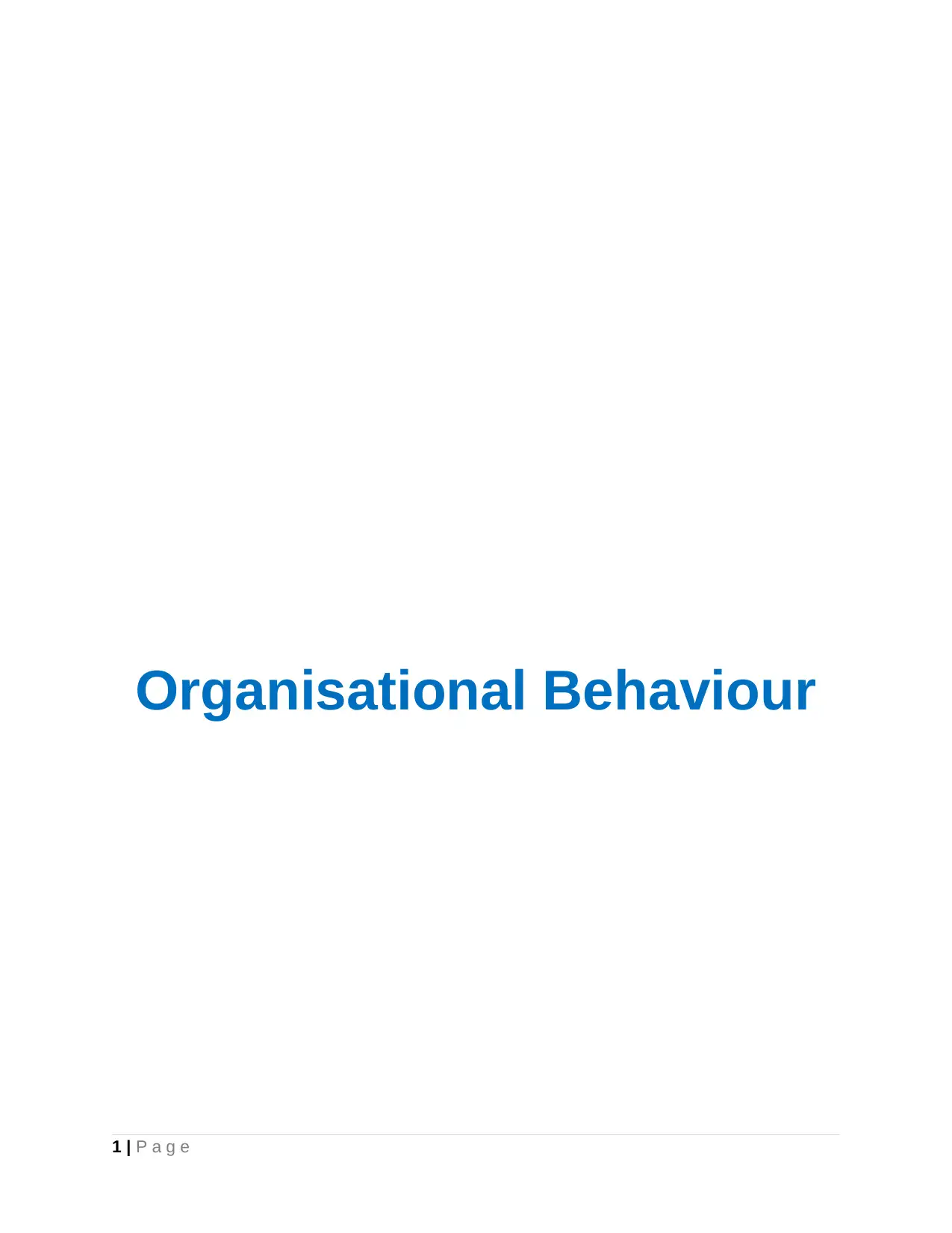
Organisational Behaviour
1 | P a g e
1 | P a g e
Paraphrase This Document
Need a fresh take? Get an instant paraphrase of this document with our AI Paraphraser
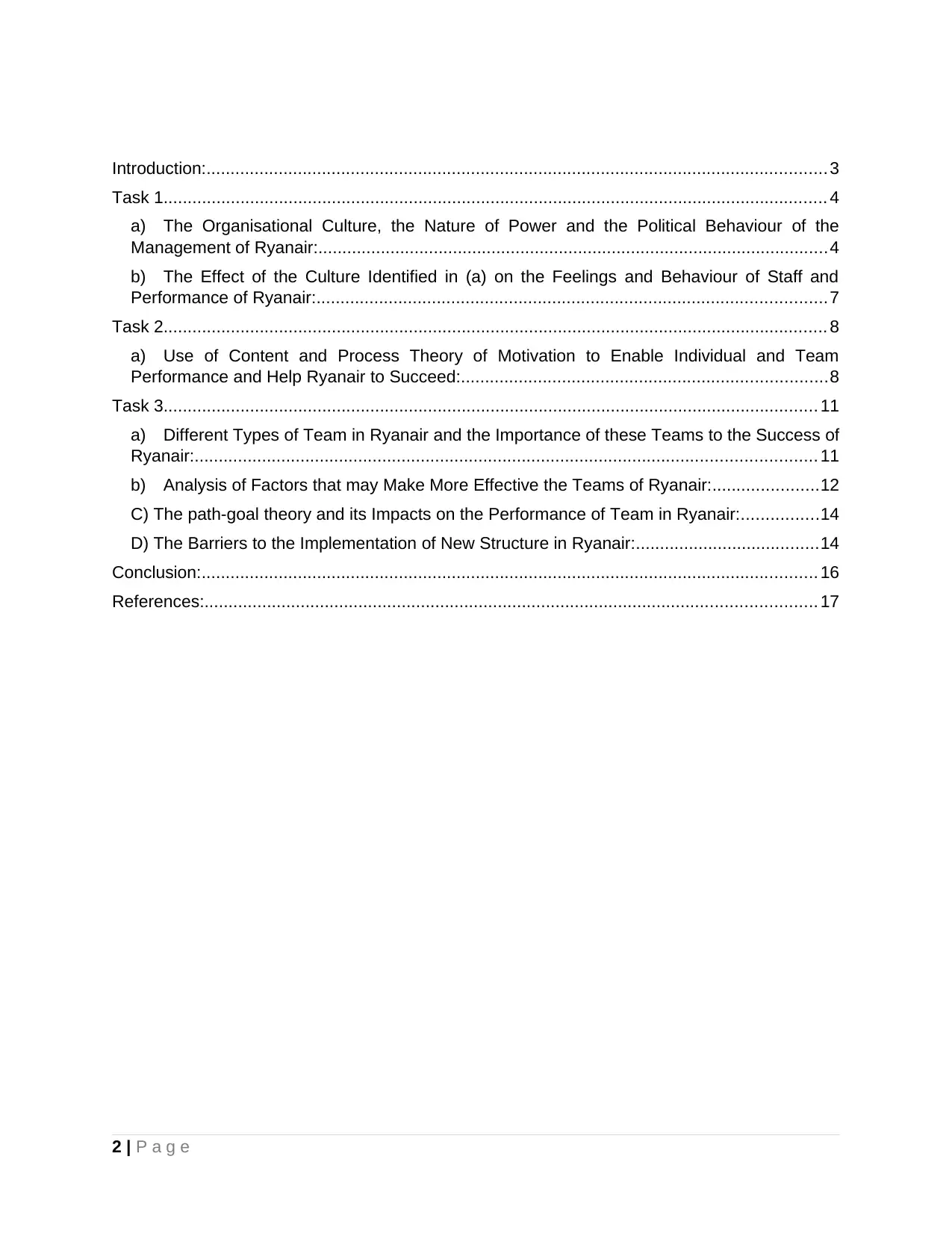
Introduction:................................................................................................................................. 3
Task 1.......................................................................................................................................... 4
a) The Organisational Culture, the Nature of Power and the Political Behaviour of the
Management of Ryanair:..........................................................................................................4
b) The Effect of the Culture Identified in (a) on the Feelings and Behaviour of Staff and
Performance of Ryanair:..........................................................................................................7
Task 2.......................................................................................................................................... 8
a) Use of Content and Process Theory of Motivation to Enable Individual and Team
Performance and Help Ryanair to Succeed:............................................................................8
Task 3........................................................................................................................................ 11
a) Different Types of Team in Ryanair and the Importance of these Teams to the Success of
Ryanair:................................................................................................................................. 11
b) Analysis of Factors that may Make More Effective the Teams of Ryanair:......................12
C) The path-goal theory and its Impacts on the Performance of Team in Ryanair:................14
D) The Barriers to the Implementation of New Structure in Ryanair:......................................14
Conclusion:................................................................................................................................ 16
References:............................................................................................................................... 17
2 | P a g e
Task 1.......................................................................................................................................... 4
a) The Organisational Culture, the Nature of Power and the Political Behaviour of the
Management of Ryanair:..........................................................................................................4
b) The Effect of the Culture Identified in (a) on the Feelings and Behaviour of Staff and
Performance of Ryanair:..........................................................................................................7
Task 2.......................................................................................................................................... 8
a) Use of Content and Process Theory of Motivation to Enable Individual and Team
Performance and Help Ryanair to Succeed:............................................................................8
Task 3........................................................................................................................................ 11
a) Different Types of Team in Ryanair and the Importance of these Teams to the Success of
Ryanair:................................................................................................................................. 11
b) Analysis of Factors that may Make More Effective the Teams of Ryanair:......................12
C) The path-goal theory and its Impacts on the Performance of Team in Ryanair:................14
D) The Barriers to the Implementation of New Structure in Ryanair:......................................14
Conclusion:................................................................................................................................ 16
References:............................................................................................................................... 17
2 | P a g e
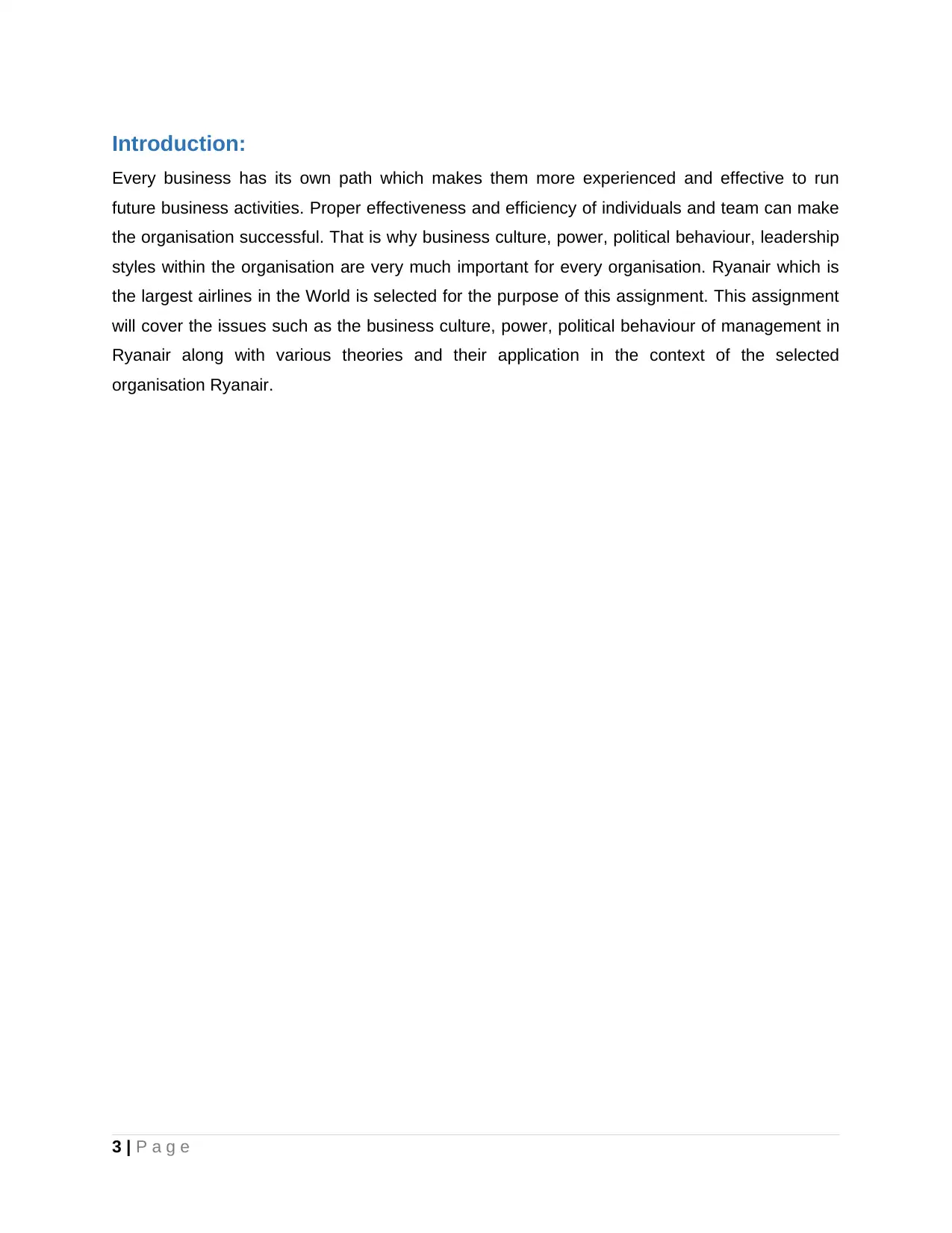
Introduction:
Every business has its own path which makes them more experienced and effective to run
future business activities. Proper effectiveness and efficiency of individuals and team can make
the organisation successful. That is why business culture, power, political behaviour, leadership
styles within the organisation are very much important for every organisation. Ryanair which is
the largest airlines in the World is selected for the purpose of this assignment. This assignment
will cover the issues such as the business culture, power, political behaviour of management in
Ryanair along with various theories and their application in the context of the selected
organisation Ryanair.
3 | P a g e
Every business has its own path which makes them more experienced and effective to run
future business activities. Proper effectiveness and efficiency of individuals and team can make
the organisation successful. That is why business culture, power, political behaviour, leadership
styles within the organisation are very much important for every organisation. Ryanair which is
the largest airlines in the World is selected for the purpose of this assignment. This assignment
will cover the issues such as the business culture, power, political behaviour of management in
Ryanair along with various theories and their application in the context of the selected
organisation Ryanair.
3 | P a g e
⊘ This is a preview!⊘
Do you want full access?
Subscribe today to unlock all pages.

Trusted by 1+ million students worldwide
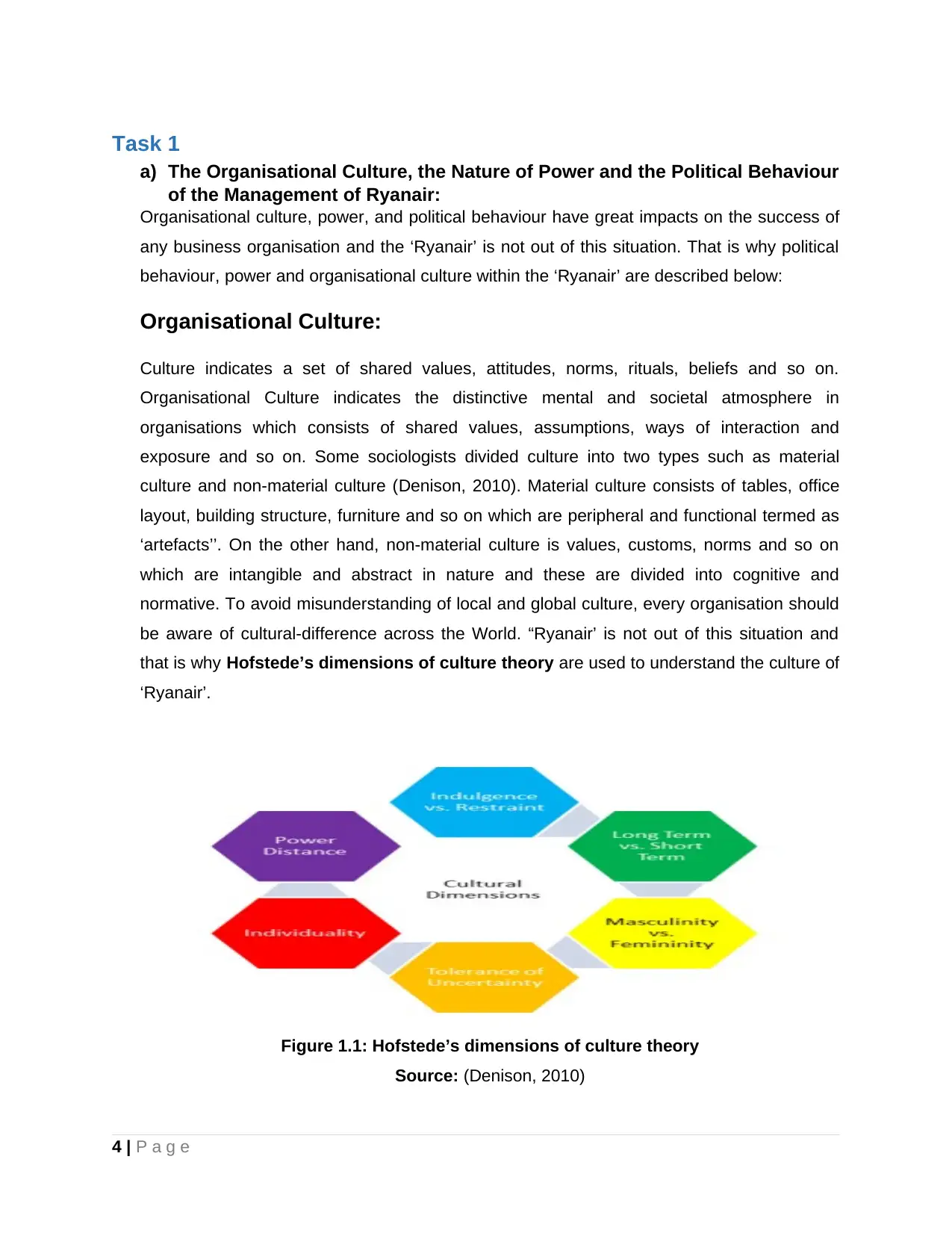
Task 1
a) The Organisational Culture, the Nature of Power and the Political Behaviour
of the Management of Ryanair:
Organisational culture, power, and political behaviour have great impacts on the success of
any business organisation and the ‘Ryanair’ is not out of this situation. That is why political
behaviour, power and organisational culture within the ‘Ryanair’ are described below:
Organisational Culture:
Culture indicates a set of shared values, attitudes, norms, rituals, beliefs and so on.
Organisational Culture indicates the distinctive mental and societal atmosphere in
organisations which consists of shared values, assumptions, ways of interaction and
exposure and so on. Some sociologists divided culture into two types such as material
culture and non-material culture (Denison, 2010). Material culture consists of tables, office
layout, building structure, furniture and so on which are peripheral and functional termed as
‘artefacts’’. On the other hand, non-material culture is values, customs, norms and so on
which are intangible and abstract in nature and these are divided into cognitive and
normative. To avoid misunderstanding of local and global culture, every organisation should
be aware of cultural-difference across the World. “Ryanair’ is not out of this situation and
that is why Hofstede’s dimensions of culture theory are used to understand the culture of
‘Ryanair’.
Figure 1.1: Hofstede’s dimensions of culture theory
Source: (Denison, 2010)
4 | P a g e
a) The Organisational Culture, the Nature of Power and the Political Behaviour
of the Management of Ryanair:
Organisational culture, power, and political behaviour have great impacts on the success of
any business organisation and the ‘Ryanair’ is not out of this situation. That is why political
behaviour, power and organisational culture within the ‘Ryanair’ are described below:
Organisational Culture:
Culture indicates a set of shared values, attitudes, norms, rituals, beliefs and so on.
Organisational Culture indicates the distinctive mental and societal atmosphere in
organisations which consists of shared values, assumptions, ways of interaction and
exposure and so on. Some sociologists divided culture into two types such as material
culture and non-material culture (Denison, 2010). Material culture consists of tables, office
layout, building structure, furniture and so on which are peripheral and functional termed as
‘artefacts’’. On the other hand, non-material culture is values, customs, norms and so on
which are intangible and abstract in nature and these are divided into cognitive and
normative. To avoid misunderstanding of local and global culture, every organisation should
be aware of cultural-difference across the World. “Ryanair’ is not out of this situation and
that is why Hofstede’s dimensions of culture theory are used to understand the culture of
‘Ryanair’.
Figure 1.1: Hofstede’s dimensions of culture theory
Source: (Denison, 2010)
4 | P a g e
Paraphrase This Document
Need a fresh take? Get an instant paraphrase of this document with our AI Paraphraser
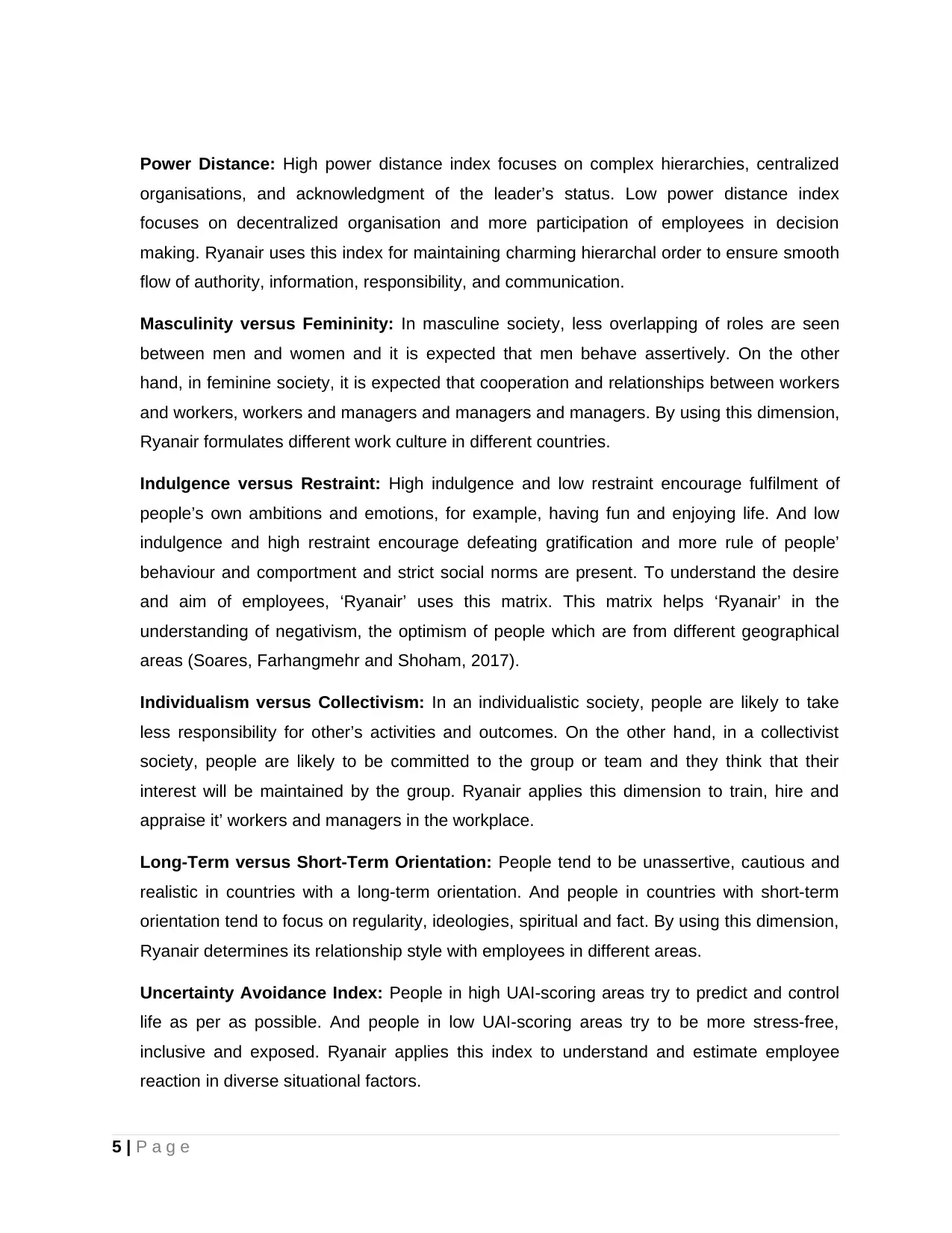
Power Distance: High power distance index focuses on complex hierarchies, centralized
organisations, and acknowledgment of the leader’s status. Low power distance index
focuses on decentralized organisation and more participation of employees in decision
making. Ryanair uses this index for maintaining charming hierarchal order to ensure smooth
flow of authority, information, responsibility, and communication.
Masculinity versus Femininity: In masculine society, less overlapping of roles are seen
between men and women and it is expected that men behave assertively. On the other
hand, in feminine society, it is expected that cooperation and relationships between workers
and workers, workers and managers and managers and managers. By using this dimension,
Ryanair formulates different work culture in different countries.
Indulgence versus Restraint: High indulgence and low restraint encourage fulfilment of
people’s own ambitions and emotions, for example, having fun and enjoying life. And low
indulgence and high restraint encourage defeating gratification and more rule of people’
behaviour and comportment and strict social norms are present. To understand the desire
and aim of employees, ‘Ryanair’ uses this matrix. This matrix helps ‘Ryanair’ in the
understanding of negativism, the optimism of people which are from different geographical
areas (Soares, Farhangmehr and Shoham, 2017).
Individualism versus Collectivism: In an individualistic society, people are likely to take
less responsibility for other’s activities and outcomes. On the other hand, in a collectivist
society, people are likely to be committed to the group or team and they think that their
interest will be maintained by the group. Ryanair applies this dimension to train, hire and
appraise it’ workers and managers in the workplace.
Long-Term versus Short-Term Orientation: People tend to be unassertive, cautious and
realistic in countries with a long-term orientation. And people in countries with short-term
orientation tend to focus on regularity, ideologies, spiritual and fact. By using this dimension,
Ryanair determines its relationship style with employees in different areas.
Uncertainty Avoidance Index: People in high UAI-scoring areas try to predict and control
life as per as possible. And people in low UAI-scoring areas try to be more stress-free,
inclusive and exposed. Ryanair applies this index to understand and estimate employee
reaction in diverse situational factors.
5 | P a g e
organisations, and acknowledgment of the leader’s status. Low power distance index
focuses on decentralized organisation and more participation of employees in decision
making. Ryanair uses this index for maintaining charming hierarchal order to ensure smooth
flow of authority, information, responsibility, and communication.
Masculinity versus Femininity: In masculine society, less overlapping of roles are seen
between men and women and it is expected that men behave assertively. On the other
hand, in feminine society, it is expected that cooperation and relationships between workers
and workers, workers and managers and managers and managers. By using this dimension,
Ryanair formulates different work culture in different countries.
Indulgence versus Restraint: High indulgence and low restraint encourage fulfilment of
people’s own ambitions and emotions, for example, having fun and enjoying life. And low
indulgence and high restraint encourage defeating gratification and more rule of people’
behaviour and comportment and strict social norms are present. To understand the desire
and aim of employees, ‘Ryanair’ uses this matrix. This matrix helps ‘Ryanair’ in the
understanding of negativism, the optimism of people which are from different geographical
areas (Soares, Farhangmehr and Shoham, 2017).
Individualism versus Collectivism: In an individualistic society, people are likely to take
less responsibility for other’s activities and outcomes. On the other hand, in a collectivist
society, people are likely to be committed to the group or team and they think that their
interest will be maintained by the group. Ryanair applies this dimension to train, hire and
appraise it’ workers and managers in the workplace.
Long-Term versus Short-Term Orientation: People tend to be unassertive, cautious and
realistic in countries with a long-term orientation. And people in countries with short-term
orientation tend to focus on regularity, ideologies, spiritual and fact. By using this dimension,
Ryanair determines its relationship style with employees in different areas.
Uncertainty Avoidance Index: People in high UAI-scoring areas try to predict and control
life as per as possible. And people in low UAI-scoring areas try to be more stress-free,
inclusive and exposed. Ryanair applies this index to understand and estimate employee
reaction in diverse situational factors.
5 | P a g e
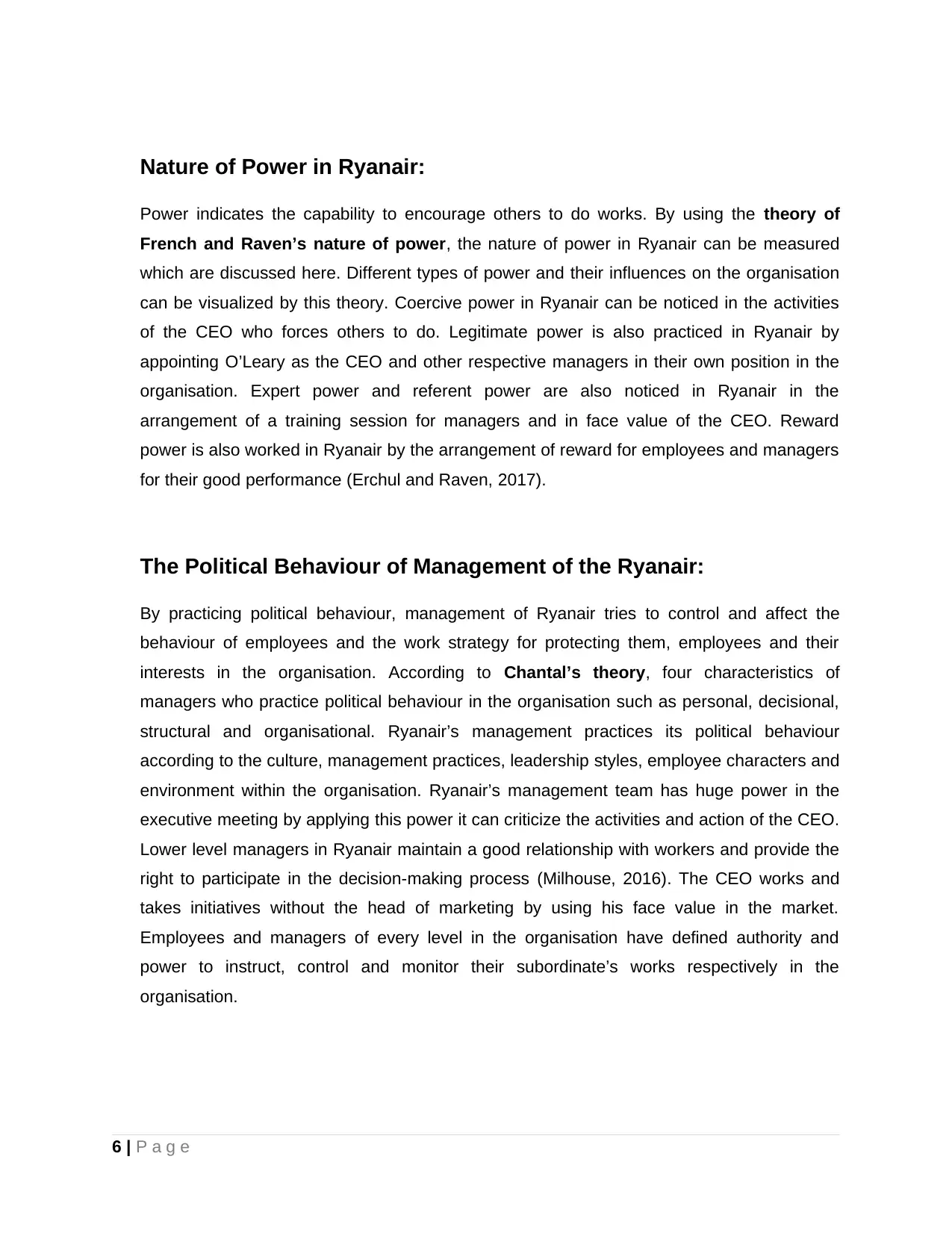
Nature of Power in Ryanair:
Power indicates the capability to encourage others to do works. By using the theory of
French and Raven’s nature of power, the nature of power in Ryanair can be measured
which are discussed here. Different types of power and their influences on the organisation
can be visualized by this theory. Coercive power in Ryanair can be noticed in the activities
of the CEO who forces others to do. Legitimate power is also practiced in Ryanair by
appointing O’Leary as the CEO and other respective managers in their own position in the
organisation. Expert power and referent power are also noticed in Ryanair in the
arrangement of a training session for managers and in face value of the CEO. Reward
power is also worked in Ryanair by the arrangement of reward for employees and managers
for their good performance (Erchul and Raven, 2017).
The Political Behaviour of Management of the Ryanair:
By practicing political behaviour, management of Ryanair tries to control and affect the
behaviour of employees and the work strategy for protecting them, employees and their
interests in the organisation. According to Chantal’s theory, four characteristics of
managers who practice political behaviour in the organisation such as personal, decisional,
structural and organisational. Ryanair’s management practices its political behaviour
according to the culture, management practices, leadership styles, employee characters and
environment within the organisation. Ryanair’s management team has huge power in the
executive meeting by applying this power it can criticize the activities and action of the CEO.
Lower level managers in Ryanair maintain a good relationship with workers and provide the
right to participate in the decision-making process (Milhouse, 2016). The CEO works and
takes initiatives without the head of marketing by using his face value in the market.
Employees and managers of every level in the organisation have defined authority and
power to instruct, control and monitor their subordinate’s works respectively in the
organisation.
6 | P a g e
Power indicates the capability to encourage others to do works. By using the theory of
French and Raven’s nature of power, the nature of power in Ryanair can be measured
which are discussed here. Different types of power and their influences on the organisation
can be visualized by this theory. Coercive power in Ryanair can be noticed in the activities
of the CEO who forces others to do. Legitimate power is also practiced in Ryanair by
appointing O’Leary as the CEO and other respective managers in their own position in the
organisation. Expert power and referent power are also noticed in Ryanair in the
arrangement of a training session for managers and in face value of the CEO. Reward
power is also worked in Ryanair by the arrangement of reward for employees and managers
for their good performance (Erchul and Raven, 2017).
The Political Behaviour of Management of the Ryanair:
By practicing political behaviour, management of Ryanair tries to control and affect the
behaviour of employees and the work strategy for protecting them, employees and their
interests in the organisation. According to Chantal’s theory, four characteristics of
managers who practice political behaviour in the organisation such as personal, decisional,
structural and organisational. Ryanair’s management practices its political behaviour
according to the culture, management practices, leadership styles, employee characters and
environment within the organisation. Ryanair’s management team has huge power in the
executive meeting by applying this power it can criticize the activities and action of the CEO.
Lower level managers in Ryanair maintain a good relationship with workers and provide the
right to participate in the decision-making process (Milhouse, 2016). The CEO works and
takes initiatives without the head of marketing by using his face value in the market.
Employees and managers of every level in the organisation have defined authority and
power to instruct, control and monitor their subordinate’s works respectively in the
organisation.
6 | P a g e
⊘ This is a preview!⊘
Do you want full access?
Subscribe today to unlock all pages.

Trusted by 1+ million students worldwide
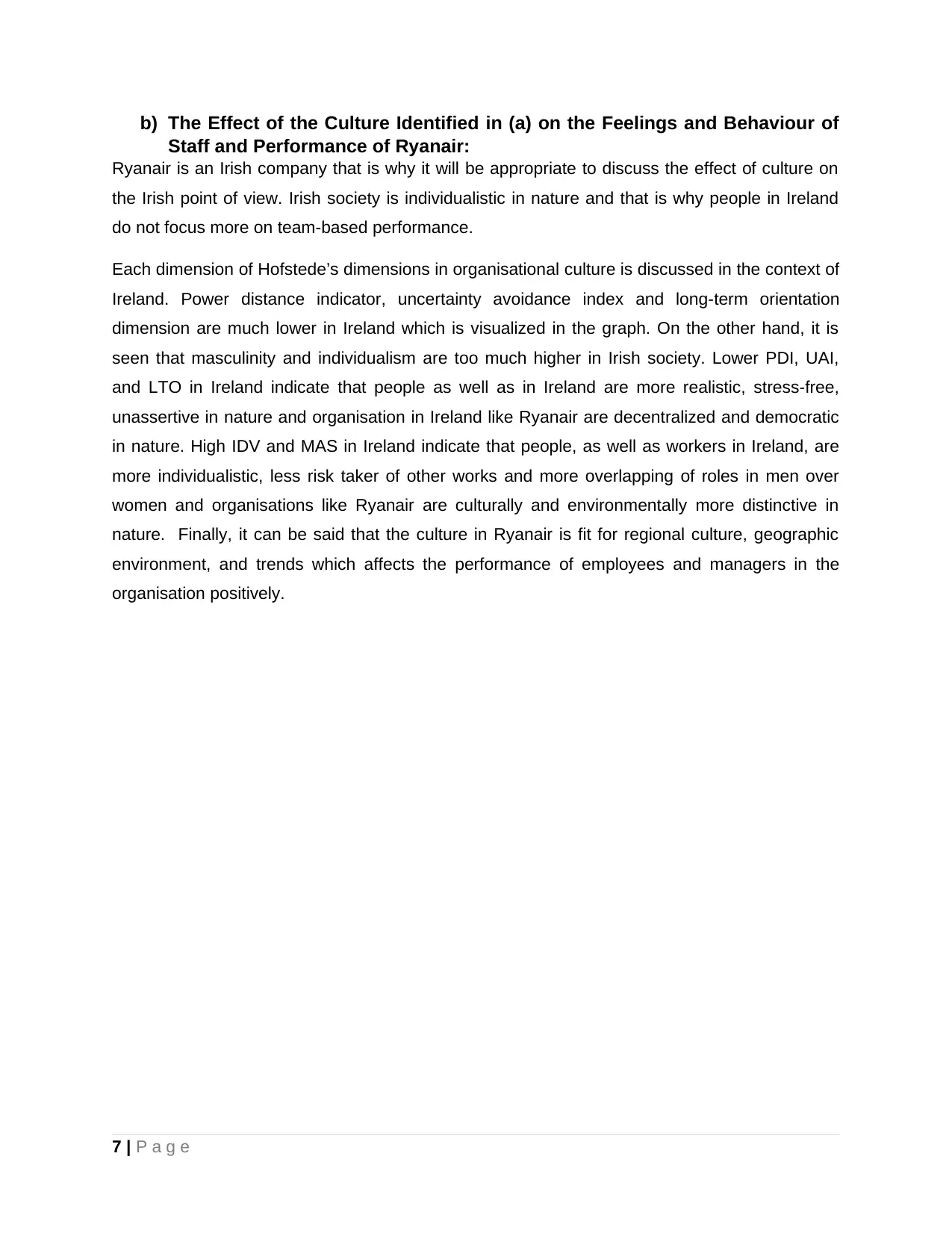
b) The Effect of the Culture Identified in (a) on the Feelings and Behaviour of
Staff and Performance of Ryanair:
Ryanair is an Irish company that is why it will be appropriate to discuss the effect of culture on
the Irish point of view. Irish society is individualistic in nature and that is why people in Ireland
do not focus more on team-based performance.
Each dimension of Hofstede’s dimensions in organisational culture is discussed in the context of
Ireland. Power distance indicator, uncertainty avoidance index and long-term orientation
dimension are much lower in Ireland which is visualized in the graph. On the other hand, it is
seen that masculinity and individualism are too much higher in Irish society. Lower PDI, UAI,
and LTO in Ireland indicate that people as well as in Ireland are more realistic, stress-free,
unassertive in nature and organisation in Ireland like Ryanair are decentralized and democratic
in nature. High IDV and MAS in Ireland indicate that people, as well as workers in Ireland, are
more individualistic, less risk taker of other works and more overlapping of roles in men over
women and organisations like Ryanair are culturally and environmentally more distinctive in
nature. Finally, it can be said that the culture in Ryanair is fit for regional culture, geographic
environment, and trends which affects the performance of employees and managers in the
organisation positively.
7 | P a g e
Staff and Performance of Ryanair:
Ryanair is an Irish company that is why it will be appropriate to discuss the effect of culture on
the Irish point of view. Irish society is individualistic in nature and that is why people in Ireland
do not focus more on team-based performance.
Each dimension of Hofstede’s dimensions in organisational culture is discussed in the context of
Ireland. Power distance indicator, uncertainty avoidance index and long-term orientation
dimension are much lower in Ireland which is visualized in the graph. On the other hand, it is
seen that masculinity and individualism are too much higher in Irish society. Lower PDI, UAI,
and LTO in Ireland indicate that people as well as in Ireland are more realistic, stress-free,
unassertive in nature and organisation in Ireland like Ryanair are decentralized and democratic
in nature. High IDV and MAS in Ireland indicate that people, as well as workers in Ireland, are
more individualistic, less risk taker of other works and more overlapping of roles in men over
women and organisations like Ryanair are culturally and environmentally more distinctive in
nature. Finally, it can be said that the culture in Ryanair is fit for regional culture, geographic
environment, and trends which affects the performance of employees and managers in the
organisation positively.
7 | P a g e
Paraphrase This Document
Need a fresh take? Get an instant paraphrase of this document with our AI Paraphraser
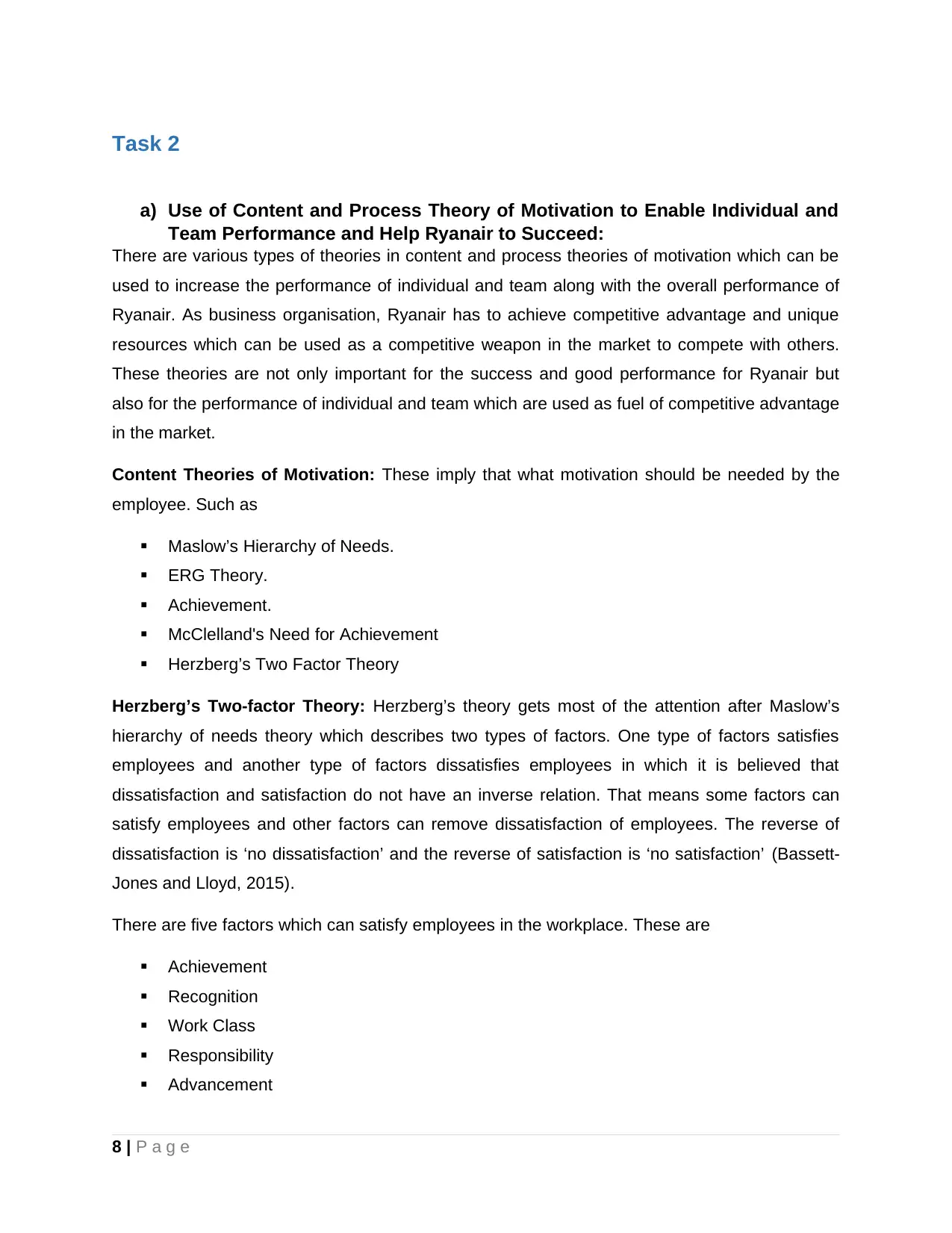
Task 2
a) Use of Content and Process Theory of Motivation to Enable Individual and
Team Performance and Help Ryanair to Succeed:
There are various types of theories in content and process theories of motivation which can be
used to increase the performance of individual and team along with the overall performance of
Ryanair. As business organisation, Ryanair has to achieve competitive advantage and unique
resources which can be used as a competitive weapon in the market to compete with others.
These theories are not only important for the success and good performance for Ryanair but
also for the performance of individual and team which are used as fuel of competitive advantage
in the market.
Content Theories of Motivation: These imply that what motivation should be needed by the
employee. Such as
Maslow’s Hierarchy of Needs.
ERG Theory.
Achievement.
McClelland's Need for Achievement
Herzberg’s Two Factor Theory
Herzberg’s Two-factor Theory: Herzberg’s theory gets most of the attention after Maslow’s
hierarchy of needs theory which describes two types of factors. One type of factors satisfies
employees and another type of factors dissatisfies employees in which it is believed that
dissatisfaction and satisfaction do not have an inverse relation. That means some factors can
satisfy employees and other factors can remove dissatisfaction of employees. The reverse of
dissatisfaction is ‘no dissatisfaction’ and the reverse of satisfaction is ‘no satisfaction’ (Bassett-
Jones and Lloyd, 2015).
There are five factors which can satisfy employees in the workplace. These are
Achievement
Recognition
Work Class
Responsibility
Advancement
8 | P a g e
a) Use of Content and Process Theory of Motivation to Enable Individual and
Team Performance and Help Ryanair to Succeed:
There are various types of theories in content and process theories of motivation which can be
used to increase the performance of individual and team along with the overall performance of
Ryanair. As business organisation, Ryanair has to achieve competitive advantage and unique
resources which can be used as a competitive weapon in the market to compete with others.
These theories are not only important for the success and good performance for Ryanair but
also for the performance of individual and team which are used as fuel of competitive advantage
in the market.
Content Theories of Motivation: These imply that what motivation should be needed by the
employee. Such as
Maslow’s Hierarchy of Needs.
ERG Theory.
Achievement.
McClelland's Need for Achievement
Herzberg’s Two Factor Theory
Herzberg’s Two-factor Theory: Herzberg’s theory gets most of the attention after Maslow’s
hierarchy of needs theory which describes two types of factors. One type of factors satisfies
employees and another type of factors dissatisfies employees in which it is believed that
dissatisfaction and satisfaction do not have an inverse relation. That means some factors can
satisfy employees and other factors can remove dissatisfaction of employees. The reverse of
dissatisfaction is ‘no dissatisfaction’ and the reverse of satisfaction is ‘no satisfaction’ (Bassett-
Jones and Lloyd, 2015).
There are five factors which can satisfy employees in the workplace. These are
Achievement
Recognition
Work Class
Responsibility
Advancement
8 | P a g e
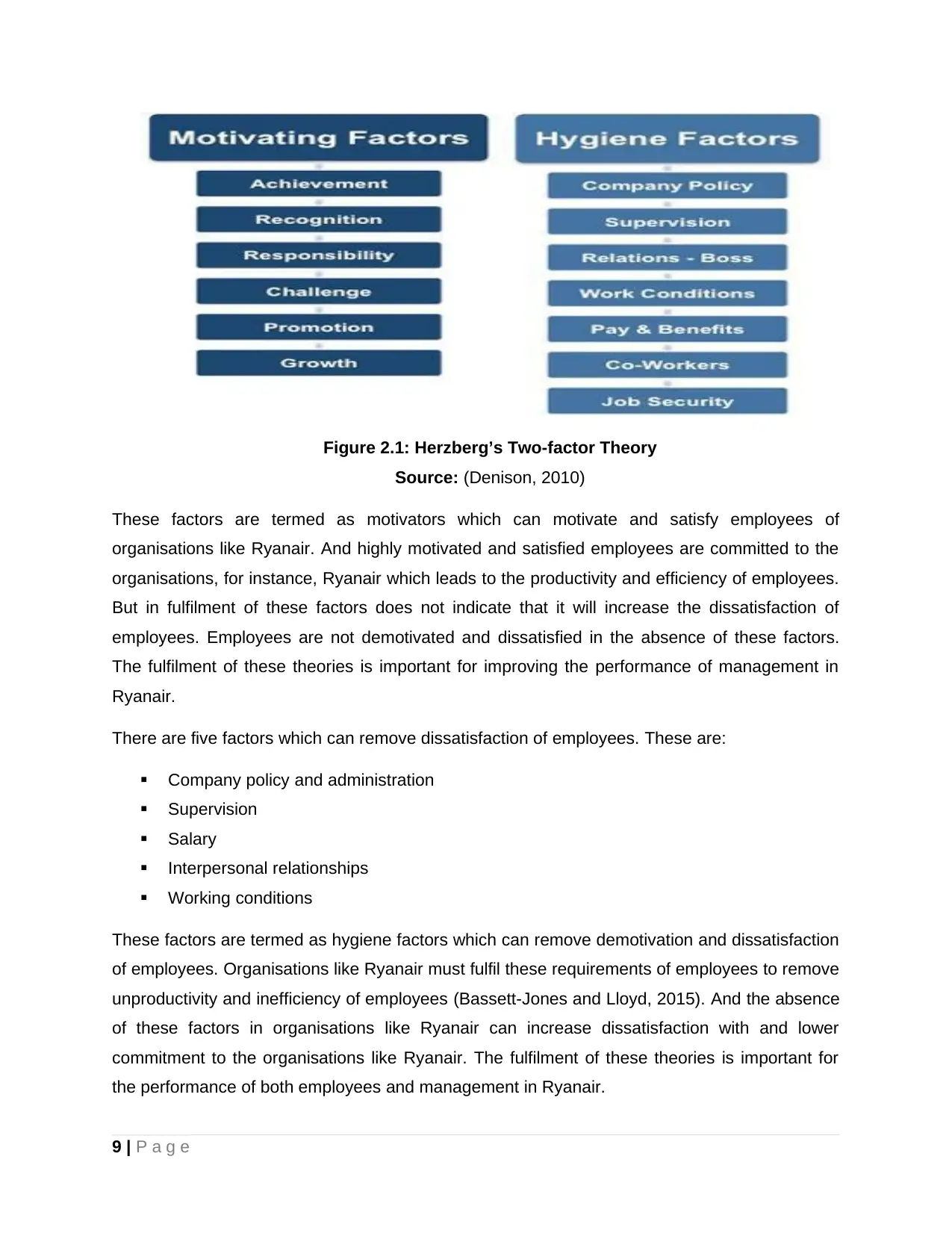
Figure 2.1: Herzberg’s Two-factor Theory
Source: (Denison, 2010)
These factors are termed as motivators which can motivate and satisfy employees of
organisations like Ryanair. And highly motivated and satisfied employees are committed to the
organisations, for instance, Ryanair which leads to the productivity and efficiency of employees.
But in fulfilment of these factors does not indicate that it will increase the dissatisfaction of
employees. Employees are not demotivated and dissatisfied in the absence of these factors.
The fulfilment of these theories is important for improving the performance of management in
Ryanair.
There are five factors which can remove dissatisfaction of employees. These are:
Company policy and administration
Supervision
Salary
Interpersonal relationships
Working conditions
These factors are termed as hygiene factors which can remove demotivation and dissatisfaction
of employees. Organisations like Ryanair must fulfil these requirements of employees to remove
unproductivity and inefficiency of employees (Bassett-Jones and Lloyd, 2015). And the absence
of these factors in organisations like Ryanair can increase dissatisfaction with and lower
commitment to the organisations like Ryanair. The fulfilment of these theories is important for
the performance of both employees and management in Ryanair.
9 | P a g e
Source: (Denison, 2010)
These factors are termed as motivators which can motivate and satisfy employees of
organisations like Ryanair. And highly motivated and satisfied employees are committed to the
organisations, for instance, Ryanair which leads to the productivity and efficiency of employees.
But in fulfilment of these factors does not indicate that it will increase the dissatisfaction of
employees. Employees are not demotivated and dissatisfied in the absence of these factors.
The fulfilment of these theories is important for improving the performance of management in
Ryanair.
There are five factors which can remove dissatisfaction of employees. These are:
Company policy and administration
Supervision
Salary
Interpersonal relationships
Working conditions
These factors are termed as hygiene factors which can remove demotivation and dissatisfaction
of employees. Organisations like Ryanair must fulfil these requirements of employees to remove
unproductivity and inefficiency of employees (Bassett-Jones and Lloyd, 2015). And the absence
of these factors in organisations like Ryanair can increase dissatisfaction with and lower
commitment to the organisations like Ryanair. The fulfilment of these theories is important for
the performance of both employees and management in Ryanair.
9 | P a g e
⊘ This is a preview!⊘
Do you want full access?
Subscribe today to unlock all pages.

Trusted by 1+ million students worldwide
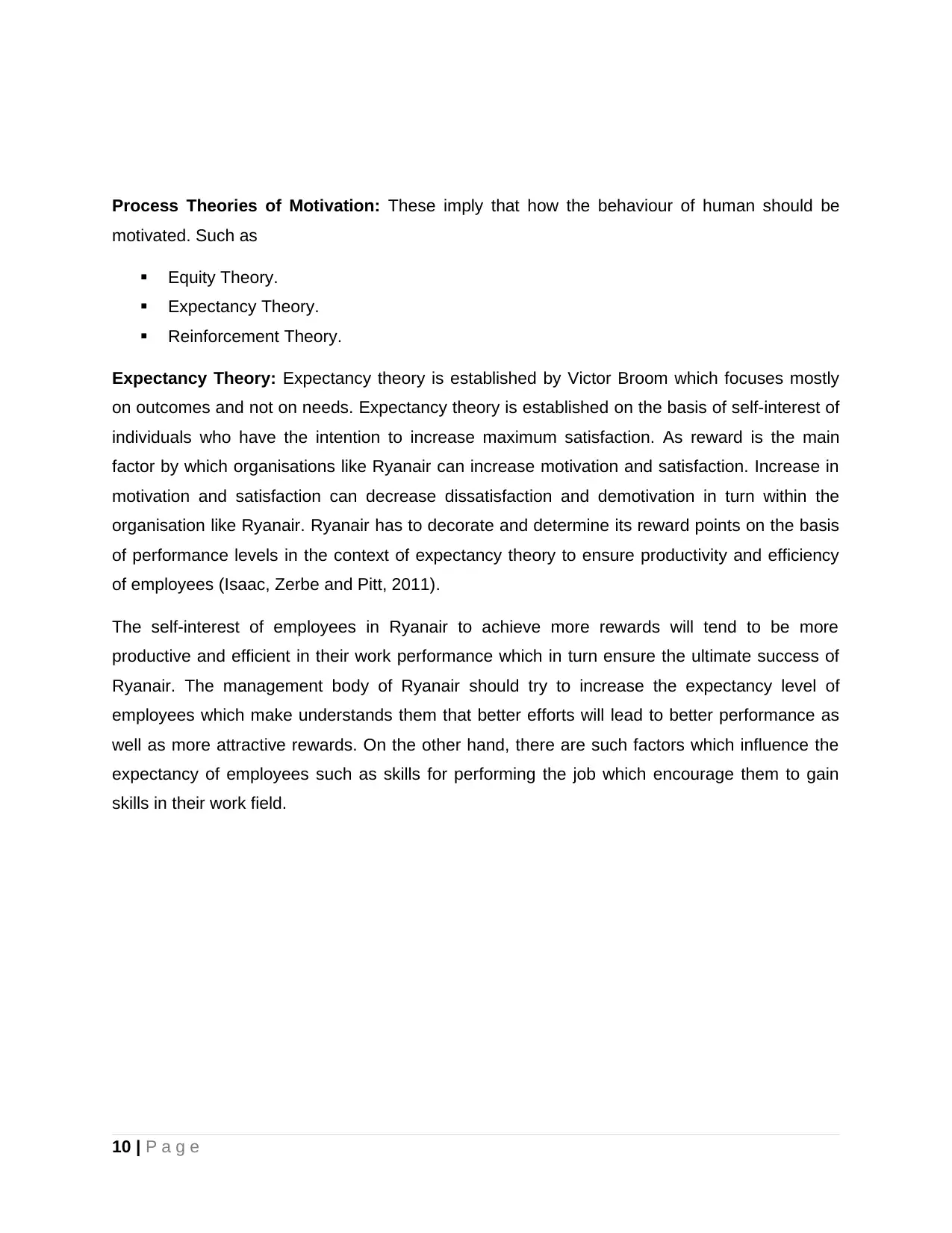
Process Theories of Motivation: These imply that how the behaviour of human should be
motivated. Such as
Equity Theory.
Expectancy Theory.
Reinforcement Theory.
Expectancy Theory: Expectancy theory is established by Victor Broom which focuses mostly
on outcomes and not on needs. Expectancy theory is established on the basis of self-interest of
individuals who have the intention to increase maximum satisfaction. As reward is the main
factor by which organisations like Ryanair can increase motivation and satisfaction. Increase in
motivation and satisfaction can decrease dissatisfaction and demotivation in turn within the
organisation like Ryanair. Ryanair has to decorate and determine its reward points on the basis
of performance levels in the context of expectancy theory to ensure productivity and efficiency
of employees (Isaac, Zerbe and Pitt, 2011).
The self-interest of employees in Ryanair to achieve more rewards will tend to be more
productive and efficient in their work performance which in turn ensure the ultimate success of
Ryanair. The management body of Ryanair should try to increase the expectancy level of
employees which make understands them that better efforts will lead to better performance as
well as more attractive rewards. On the other hand, there are such factors which influence the
expectancy of employees such as skills for performing the job which encourage them to gain
skills in their work field.
10 | P a g e
motivated. Such as
Equity Theory.
Expectancy Theory.
Reinforcement Theory.
Expectancy Theory: Expectancy theory is established by Victor Broom which focuses mostly
on outcomes and not on needs. Expectancy theory is established on the basis of self-interest of
individuals who have the intention to increase maximum satisfaction. As reward is the main
factor by which organisations like Ryanair can increase motivation and satisfaction. Increase in
motivation and satisfaction can decrease dissatisfaction and demotivation in turn within the
organisation like Ryanair. Ryanair has to decorate and determine its reward points on the basis
of performance levels in the context of expectancy theory to ensure productivity and efficiency
of employees (Isaac, Zerbe and Pitt, 2011).
The self-interest of employees in Ryanair to achieve more rewards will tend to be more
productive and efficient in their work performance which in turn ensure the ultimate success of
Ryanair. The management body of Ryanair should try to increase the expectancy level of
employees which make understands them that better efforts will lead to better performance as
well as more attractive rewards. On the other hand, there are such factors which influence the
expectancy of employees such as skills for performing the job which encourage them to gain
skills in their work field.
10 | P a g e
Paraphrase This Document
Need a fresh take? Get an instant paraphrase of this document with our AI Paraphraser
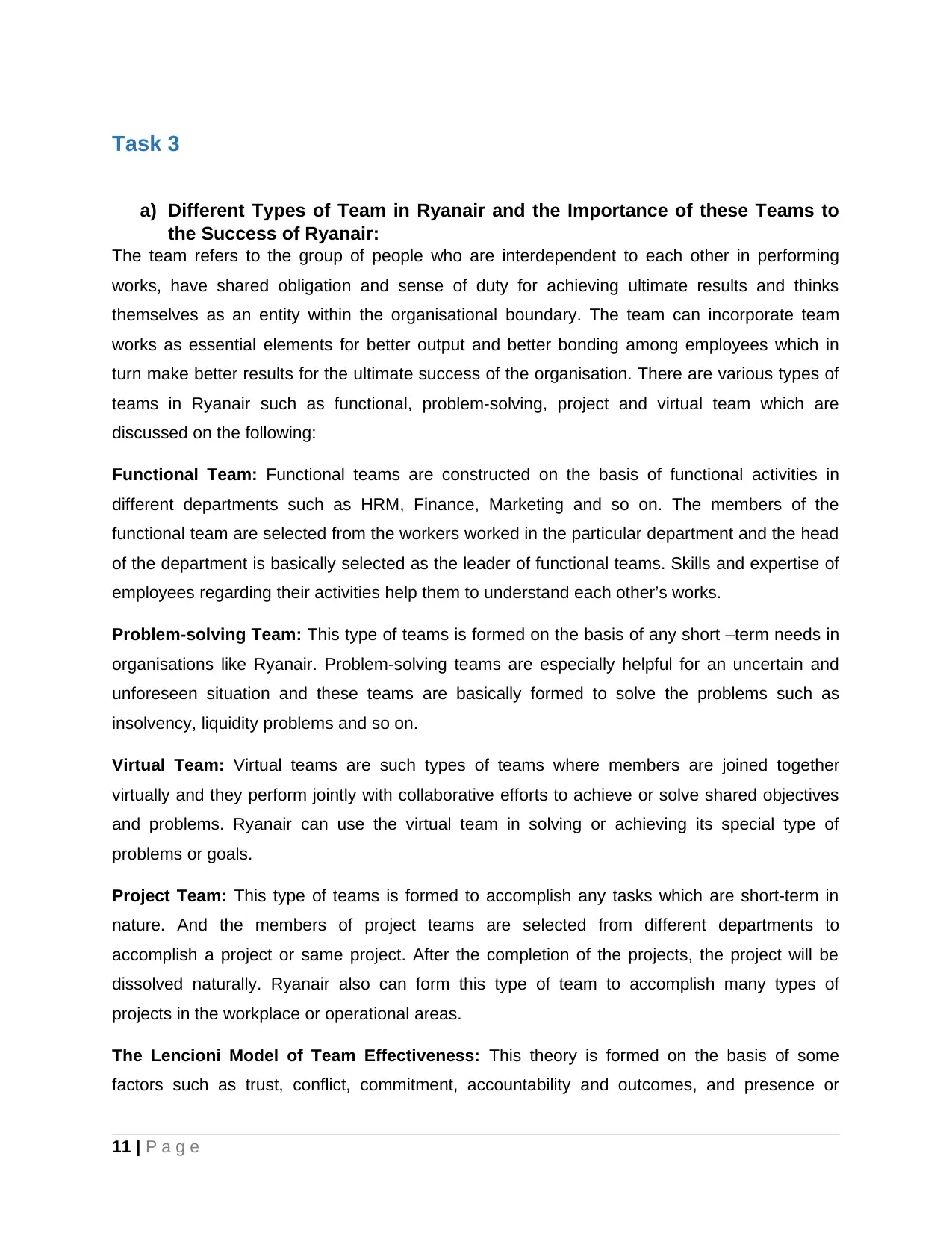
Task 3
a) Different Types of Team in Ryanair and the Importance of these Teams to
the Success of Ryanair:
The team refers to the group of people who are interdependent to each other in performing
works, have shared obligation and sense of duty for achieving ultimate results and thinks
themselves as an entity within the organisational boundary. The team can incorporate team
works as essential elements for better output and better bonding among employees which in
turn make better results for the ultimate success of the organisation. There are various types of
teams in Ryanair such as functional, problem-solving, project and virtual team which are
discussed on the following:
Functional Team: Functional teams are constructed on the basis of functional activities in
different departments such as HRM, Finance, Marketing and so on. The members of the
functional team are selected from the workers worked in the particular department and the head
of the department is basically selected as the leader of functional teams. Skills and expertise of
employees regarding their activities help them to understand each other’s works.
Problem-solving Team: This type of teams is formed on the basis of any short –term needs in
organisations like Ryanair. Problem-solving teams are especially helpful for an uncertain and
unforeseen situation and these teams are basically formed to solve the problems such as
insolvency, liquidity problems and so on.
Virtual Team: Virtual teams are such types of teams where members are joined together
virtually and they perform jointly with collaborative efforts to achieve or solve shared objectives
and problems. Ryanair can use the virtual team in solving or achieving its special type of
problems or goals.
Project Team: This type of teams is formed to accomplish any tasks which are short-term in
nature. And the members of project teams are selected from different departments to
accomplish a project or same project. After the completion of the projects, the project will be
dissolved naturally. Ryanair also can form this type of team to accomplish many types of
projects in the workplace or operational areas.
The Lencioni Model of Team Effectiveness: This theory is formed on the basis of some
factors such as trust, conflict, commitment, accountability and outcomes, and presence or
11 | P a g e
a) Different Types of Team in Ryanair and the Importance of these Teams to
the Success of Ryanair:
The team refers to the group of people who are interdependent to each other in performing
works, have shared obligation and sense of duty for achieving ultimate results and thinks
themselves as an entity within the organisational boundary. The team can incorporate team
works as essential elements for better output and better bonding among employees which in
turn make better results for the ultimate success of the organisation. There are various types of
teams in Ryanair such as functional, problem-solving, project and virtual team which are
discussed on the following:
Functional Team: Functional teams are constructed on the basis of functional activities in
different departments such as HRM, Finance, Marketing and so on. The members of the
functional team are selected from the workers worked in the particular department and the head
of the department is basically selected as the leader of functional teams. Skills and expertise of
employees regarding their activities help them to understand each other’s works.
Problem-solving Team: This type of teams is formed on the basis of any short –term needs in
organisations like Ryanair. Problem-solving teams are especially helpful for an uncertain and
unforeseen situation and these teams are basically formed to solve the problems such as
insolvency, liquidity problems and so on.
Virtual Team: Virtual teams are such types of teams where members are joined together
virtually and they perform jointly with collaborative efforts to achieve or solve shared objectives
and problems. Ryanair can use the virtual team in solving or achieving its special type of
problems or goals.
Project Team: This type of teams is formed to accomplish any tasks which are short-term in
nature. And the members of project teams are selected from different departments to
accomplish a project or same project. After the completion of the projects, the project will be
dissolved naturally. Ryanair also can form this type of team to accomplish many types of
projects in the workplace or operational areas.
The Lencioni Model of Team Effectiveness: This theory is formed on the basis of some
factors such as trust, conflict, commitment, accountability and outcomes, and presence or
11 | P a g e
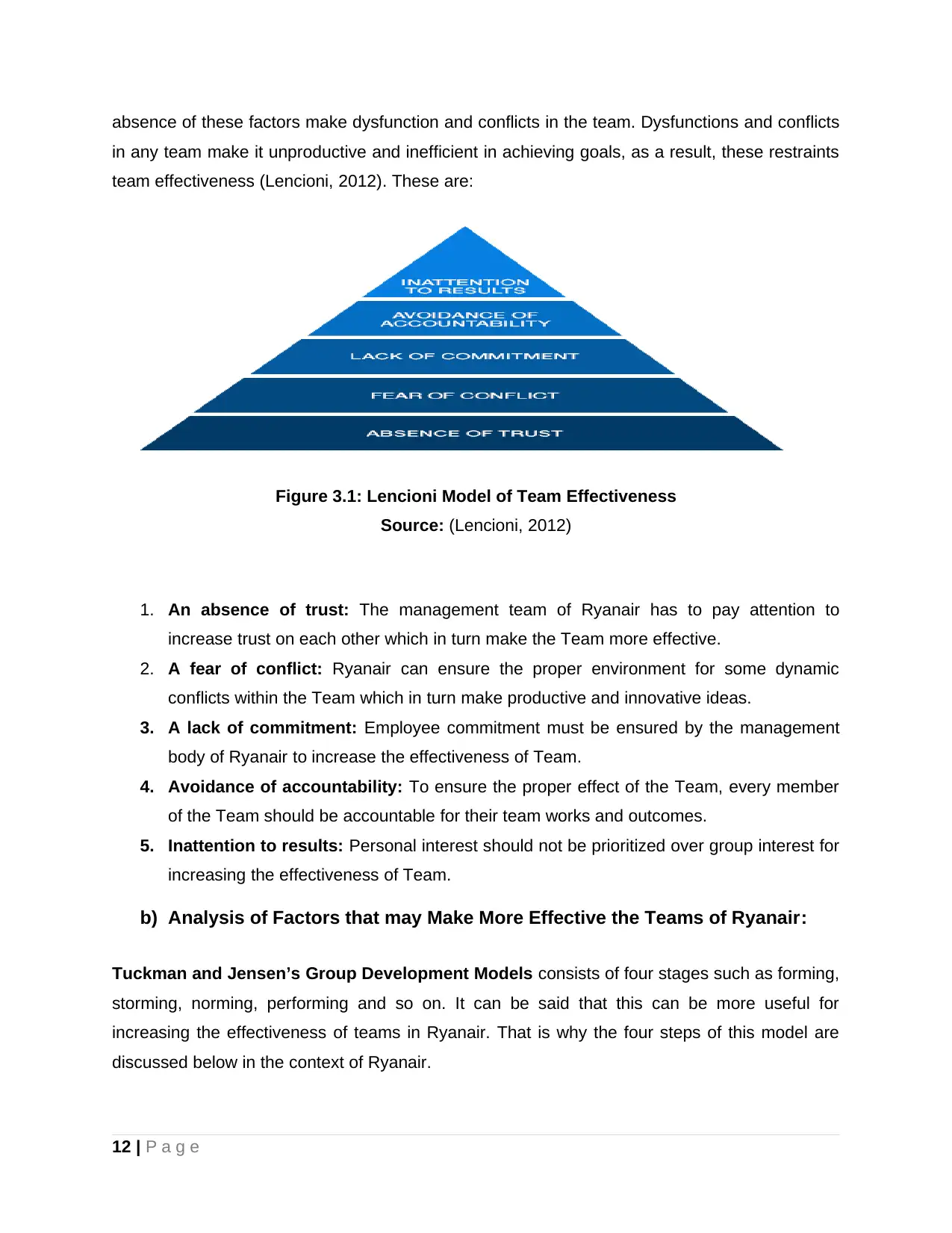
absence of these factors make dysfunction and conflicts in the team. Dysfunctions and conflicts
in any team make it unproductive and inefficient in achieving goals, as a result, these restraints
team effectiveness (Lencioni, 2012). These are:
Figure 3.1: Lencioni Model of Team Effectiveness
Source: (Lencioni, 2012)
1. An absence of trust: The management team of Ryanair has to pay attention to
increase trust on each other which in turn make the Team more effective.
2. A fear of conflict: Ryanair can ensure the proper environment for some dynamic
conflicts within the Team which in turn make productive and innovative ideas.
3. A lack of commitment: Employee commitment must be ensured by the management
body of Ryanair to increase the effectiveness of Team.
4. Avoidance of accountability: To ensure the proper effect of the Team, every member
of the Team should be accountable for their team works and outcomes.
5. Inattention to results: Personal interest should not be prioritized over group interest for
increasing the effectiveness of Team.
b) Analysis of Factors that may Make More Effective the Teams of Ryanair:
Tuckman and Jensen’s Group Development Models consists of four stages such as forming,
storming, norming, performing and so on. It can be said that this can be more useful for
increasing the effectiveness of teams in Ryanair. That is why the four steps of this model are
discussed below in the context of Ryanair.
12 | P a g e
in any team make it unproductive and inefficient in achieving goals, as a result, these restraints
team effectiveness (Lencioni, 2012). These are:
Figure 3.1: Lencioni Model of Team Effectiveness
Source: (Lencioni, 2012)
1. An absence of trust: The management team of Ryanair has to pay attention to
increase trust on each other which in turn make the Team more effective.
2. A fear of conflict: Ryanair can ensure the proper environment for some dynamic
conflicts within the Team which in turn make productive and innovative ideas.
3. A lack of commitment: Employee commitment must be ensured by the management
body of Ryanair to increase the effectiveness of Team.
4. Avoidance of accountability: To ensure the proper effect of the Team, every member
of the Team should be accountable for their team works and outcomes.
5. Inattention to results: Personal interest should not be prioritized over group interest for
increasing the effectiveness of Team.
b) Analysis of Factors that may Make More Effective the Teams of Ryanair:
Tuckman and Jensen’s Group Development Models consists of four stages such as forming,
storming, norming, performing and so on. It can be said that this can be more useful for
increasing the effectiveness of teams in Ryanair. That is why the four steps of this model are
discussed below in the context of Ryanair.
12 | P a g e
⊘ This is a preview!⊘
Do you want full access?
Subscribe today to unlock all pages.

Trusted by 1+ million students worldwide
1 out of 18
Related Documents
Your All-in-One AI-Powered Toolkit for Academic Success.
+13062052269
info@desklib.com
Available 24*7 on WhatsApp / Email
![[object Object]](/_next/static/media/star-bottom.7253800d.svg)
Unlock your academic potential
Copyright © 2020–2025 A2Z Services. All Rights Reserved. Developed and managed by ZUCOL.


